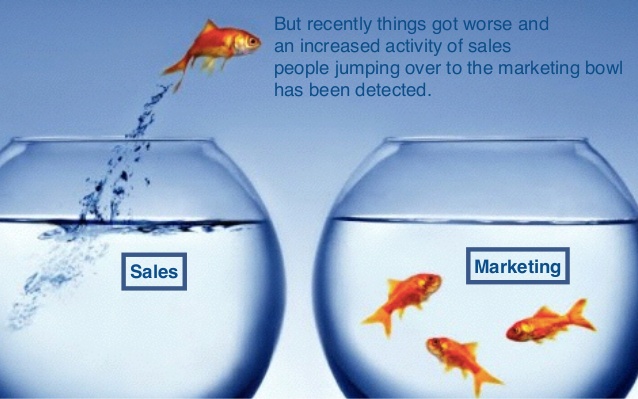 I had a freelance gig for a while writing articles for 9Lenses, and one of the articles I wrote was this jam on how to align sales and marketing. I think that’s a fairly large topic and people often avoid it, or shift the convo to other things, when it comes up.
I had a freelance gig for a while writing articles for 9Lenses, and one of the articles I wrote was this jam on how to align sales and marketing. I think that’s a fairly large topic and people often avoid it, or shift the convo to other things, when it comes up.
Here’s my two cents, before we get going: marketing is essentially a support system for sales. If marketing is doing everything right and to the tee, sales should theoretically be increasing. You can bring up arguments here that part of marketing is “protecting the brand identity” and all that, and that’s somewhat true — but revenue pays salaries, so unless you want to slice marketing headcount eventually, the fundamental goal of marketing is to raise awareness, and thus hopefully sales, of a product or idea.
The problem is often that the goals and timelines of a marketing department and a sales department are misaligned. Or, to quote Forrester, these are the core issues:
Over half of respondents — who were predominantly sales or marketing folks — decribed their working relationship as “Generally OK, but needs work.” The majority also agreed that it’s the combination of three factors:
1) Lack of communication or collaboration between marketing and sales
2) Disparate/siloed systems, data, and processes that aren’t shared between the teams, and
3) Getting measured by different objectives and metrics…
None of this should be that surprising. In terms of a lack of communication, you could say that about any two departments in any company. In terms of silos, well, same thing. And in terms of different objectives/metrics, well, that’s a pretty universal problem too.
Here’s what I’d say, for what it’s worth:
Start with the marketing side: Realize that marketing needs to evolve to meet current needs. The old models don’t necessarily work anymore.
Then consider your ‘lead generation’ program: A lot of lead-gen programs are about chasing big numbers, which ultimately doesn’t help sales because you’re filling a funnel with names/e-mails/phone numbers that may not have any real intention to buy anything. (“These leads are old and cold!”)
Then consider marketing automation: Everyone loves to chase this dream around because it seems like a way to make your uber-busy job that much easier, but in reality marketing automation is a train wreck that isn’t adaptable, and that starts to “trigger” off e-mails to your “leads” and “prospects” that ultimately may annoy them. That’s no way to work with potential clients.
Now move to sales: First off, stop following conventional advice. It’s all pretty dumb. Do what’s best for your organization.
Make your website a little more transparent: This only seems logical, no? People can see through bullshit. You’ve got a whole generation coming up who has been fed ads for their entire life on every device they access. You think they can’t ignore those? They can.
Try to communicate better: Easier said than done, yes, but it shouldn’t be so hard, especially when you consider that a core skill for salespeople really needs to be “ability to communicate.”
Here’s what I mean by “communicate better:” It will be hard to align goals and bonus incentives, yes, because “a sales guy” and “a marketing guy” do different things and have different bosses. But you could meet twice a month to share best/worst practices, for example. You could ask sales “Hey, what is marketing doing right/wrong?” and then ask marketing the same questions. Basically, get people on the same page. What does sales need from marketing? What does marketing need from sales? That’s how your personal life (family/marriage) works, right? Well, this is 1/3 of your day — and probably 1/2 your waking day, five days a week. Why not try to make it work as opposed to just bitching about how it doesn’t work?
Track progress: This gets tricky. Marketing tends to worship at The Temple of Big Numbers, because they have to — direct marketing ROI is sometimes hard to prove (a great ad or campaign doesn’t mean someone saw it and ran out and bought a bunch of Miller Lite). Sales is easier to prove, so they can chase more direct numbers. But still, if you want a small and basic way to start embracing the whole idea of “Big Data,” look at marketing campaigns, engagement levels (but not too much), sales targets, sales figures, and the like. Start actually using data as a potential driving force.


Reblogged this on Kenneth Leung, Thinking, Seeing, Living.
Reblogged this on Gr8fullsoul.